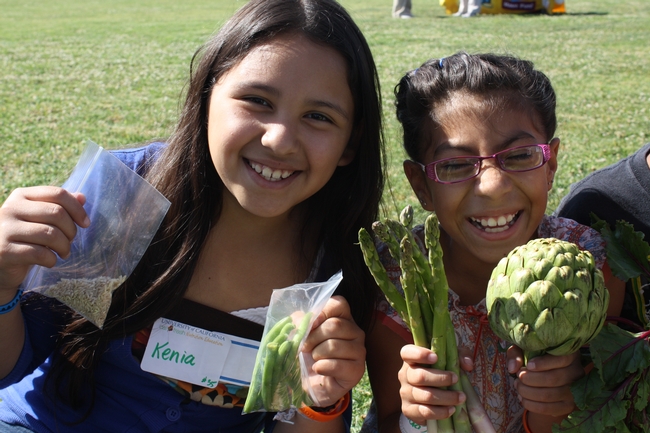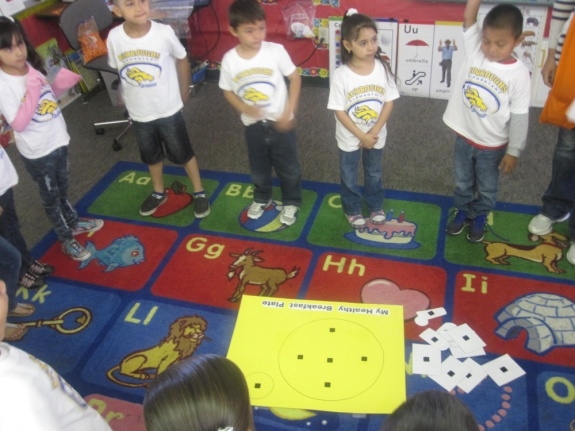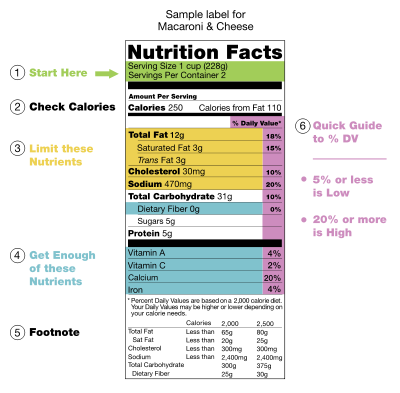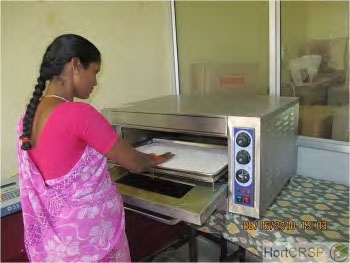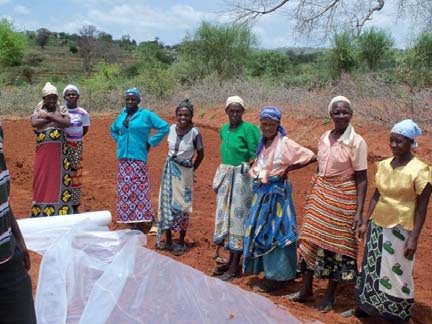Posts Tagged: Nutrition
Ever explore an artichoke?
Have you ever seen young students explore an artichoke for the first time? Their faces look puzzled as they wonder if this green spiny thing they hold before them is even edible. What about a kiwi? Eyebrows furrow in bewilderment when kids encounter this fuzzy fruit for the first time. Our favorite kiwi quote from a fifth-grade student: “This smells like dirt.”
All jokes aside, in Fresno County, nutrition education is becoming a priority for teachers. The UC CalFresh Nutrition Education Program has worked with over 950 teachers at over 80 schools throughout the county this school year. Our teachers are innovative, and continue to be outstanding in their approach to nutrition education!
While there isn’t enough space to recognize all outstanding educators, we are excited to share a few examples of the ways teachers are going above and beyond to teach students nutrition.
At Ayer Elementary, kindergarten teachers John Schnell, Donna Johnston, Catherine Uribe, and Nancy Patrick have made healthy eating and active living a priority. They actively take part in nutrition education and monthly tastings provided by UC Calfresh. They often bring in additional healthy foods for the students to sample. Understanding the importance of nutrition in a family-setting, Ayer teachers have invited UC CalFresh to partner in providing kinder parents important nutrition tips to get the year off to a healthy start.
Following a lesson taught by a UC CalFresh program coordinator at Balderas Elementary, Mrs. Nunez’s third-grade class created a collage of “Sometime vs. Anytime” foods. Mrs. Nunez went the extra step to reinforce the key concept of enjoying foods in moderation. Students took the information learned and made “anytime meals.” Students’ artwork was displayed in the hallway for all to see.
“We put our milk in, we take the milk out…and we shake it all about."
It's breakfast time at Burroughs Elementary. Mrs. Mata-Webb’s kindergarten class learned the importance of breakfast through song and dance. Students practiced building a healthy breakfast by including three of the five food groups at breakfast time.
Dedicated to ensuring the health of our students, food service staff in Fresno Unified have also gone the extra mile to help promote our adult nutrition education classes and workshops.
The educators and school staff spotlighted provide a glimpse of the endless examples of excellent nutrition education happening in Fresno County. Statewide, the UC CalFresh Nutrition Education Program is very fortunate to work with such amazing educators. At the University of California Cooperative Extension, we’re working through schools to teach kids good food habits and decision-making skills.
If you would like to have the UC CalFresh Nutrition Education Program at your school contact Shelby MacNab, (559) 600-7222 or smacnab@ucdavis.edu. For additional information, visit our website.
Food truth that we can eat
What we know about eating, not eating and overeating has been investigated by research universities and university-trained scientists since the 1920s. The Journal of Nutrition began publishing in 1928. Now 2.5 million inquiries each month probe a massive body of knowledge about the nature of our evolving physical and cultural relationship with food, with at least 30 more food and nutrition journals collecting and dispersing this science globally.
The result: Americans spend more time debating what to eat than at any other time in history. The firmly held beliefs of most adults about what should be eaten or avoided have origins in the history of this science. In spite of the intent of this research, and because it is frequently challenged, people are understandably skeptical or easily recruited to the next food fad.
As a food science graduate and later as a campus writer, I have worked smack in the center of a leading food research university for more than a decade. This vantage point allowed me to follow the path of these rivulets of research as they flow through scientific journals and later become diluted by commercial interests. They readily dribble to the media without interpretation or the full context of their intended purpose.
Perhaps the most sacred form of long-term research evidence we follow is the food label, an abbreviated version of truth that empowers our choice to follow our closely held beliefs. University research and methods also indirectly determine what will appear on labels in the future. I have long admired the pragmatic ethics of Barbara Schneeman, who taught me as a professor of nutrition and college dean before going to the U.S. Food and Drug Administration to direct the redesign of nutritional food labeling (and other regulations).
Meanwhile, efforts in the national “food court” to hold advertising accountable to the truth are gaining momentum. In spite being misused, universities remain the best source of food truth. This assumes that faculty remains free to challenge the truth and that research funds are available to validate it. Unfortunately, funding for food research is shrinking along with the federal budget, and the federal agencies responsible are seeing an increase in applications for what remains. This week, the National Research Council will release their report , Research Universities and the Future of America: Ten Breakthrough Actions Vital to Our Nation's Prosperity and Security. The report will attempt to list the top 10 actions that Congress, the federal government, states and research universities could take to assure that American research universities help the U.S. “compete, prosper, and achieve national goals for health, energy, the environment, and security in the global community.” Those of us who are watching can only hope that the food truth needed to challenge nutritional hype will be on that list.
Healthalicous cooking
Our youth deserve a future filled with promise and possibilities. A strong body and good health is the foundation on which a successful future can be built.
UC ANR’s new after-school curriculum is designed to help 9- to 12-year-olds develop good health skills that will last a lifetime. The six-week hands-on program promotes preparing and eating healthy meals as well as encouraging plenty of physical activity. Healthy eating and physical activity work together to help reduce obesity levels.
These free, downloadable lessons include:
- Let’s Make It Clean: Wash Up!
- Make It Healthy: Eat Balanced Meals
- Make It Crunchy: Go for Whole Grains!
- Make It Colorful: Choose Fruits and Veggies by Color
- Make it Delicious: Plan and Balance
- Make It Fun: Eat and Share
Addressing nutrition and poverty through horticulture
Nutrition, food security and sufficient family incomes are challenges in many parts of the world. Half the world’s people live in rural areas in developing countries. Because hunger and malnutrition are often linked to poverty, providing economic opportunities through horticultural production not only helps family incomes, but also addresses food security and nutrition. Training women to produce and market horticultural crops in the developing world also helps provide a much-needed income stream for families with children.
UC Davis is addressing food security and economic development in Africa, Southeast Asia, Central America, and elsewhere, by coordinating an international horticulture program. The Horticulture Collaborative Research Support Program (Hort CRSP; pronounced "hort crisp") is one of 10 CRSP programs that focus on global food production and solving food and nutrition problems in developing countries. UC Davis leads the Hort CRSP, with funding support from the U.S. Agency for International Development (USAID).
Examples of projects conducted by researchers and educators throughout the world include:
- Inexpensive cold storage systems in rural, developing areas to prolong food longevity; see page 2
- Concentrated solar drying of fruits and vegetables in East Africa; see page 3
- Improving safety and quality of tomatoes in Nigeria; see page 3
- Smallholder flower production in Honduras for export markets; see page 3
The overarching goals of the Hort CRSP are to reduce poverty and improve nutrition and health of the rural poor, while improving the profitability and sustainability of horticulture in the developing world. Priorities in the Hort CRSP include gender equity, sustainable crop production, postharvest technology, food safety, market access, and financing. The program awards research funding in the U.S. and abroad to:
- Realize opportunities for horticultural development
- Improve food security
- Improve nutrition and human health
- Provide opportunities for income diversification
- Advance economic and social conditions of the rural poor, particularly women
Dr. Elizabeth Mitcham, UC Cooperative Extension specialist in the Department of Plant Sciences at UC Davis and director of the Hort CRSP, notes, “By harnessing the research, training, and outreach expertise of the land-grant universities in the U.S. to work with partners in developing countries, we can improve horticultural capabilities in much the same way that the land-grant system helped revolutionize American agriculture.”
In the three years since the program’s inception, several projects have been completed, and many are ongoing. The program’s website offers a plethora of information, along with newsletters that highlight individual projects.
The program also has a YouTube channel, with videos on Hort CRSP projects. Some of the videos are about projects that are especially important in developing countries, including:
- The TRELLIS project — bringing together graduate students and in-country development organizations; YouTube link
- Using cell phones to give real-time information to growers in rural areas of India; YouTube link
- Inexpensive cultivation practices for smallholder farmers; YouTube link
- Indigenous products increase incomes in Ghana; YouTube link
- Saving indigenous crop seeds in Southeast Asia for resource-poor farmers; YouTube link
UC Davis, ranked first in the U.S. on research related to agriculture, food science and nutrition, and plant and animal science, is positioned to serve global needs related to food and nutrition. Of the 10 CRSP programs administered by USAID, two of the programs are based at UC Davis — the Hort CRSP program, and the BASIS CRSP, which was highlighted in a recent Food Blog post and addresses financial issues related to agricultural productivity.
Cultivating California
Only in California could arid land be converted into the nation’s salad bowl.
In the late 1800s, University of California researchers discovered how to remove salts from the soils of the Central Valley, turning it into one of the most productive agricultural regions.
UC researchers continue to play a key role in agriculture today, keeping California the nation’s leading agricultural state, from dairies in Tulare to nut farms in Newberry Springs.
A new brochure highlights the breadth of UC Agriculture and Natural Resources’ impact. UC guidelines have helped farmers boost broccoli production. UC scientists have developed sweet-tasting citrus and strawberries to meet consumer demands. UC certifies more than 95 percent of wine grapevines grown in the state, providing a reliable supply of high-quality vines for California’s multibillion-dollar wine industry. Whether it’s managing invasive pests, promoting nutrition or sustaining small farmers, ANR serves California’s communities with a focus on advising, educating and searching for solutions.
For more information, read the Cultivating California brochure.

uc anr minibrochure cover s2


